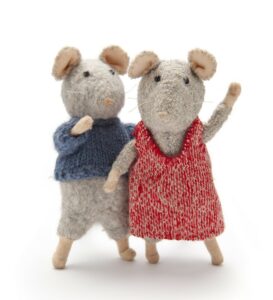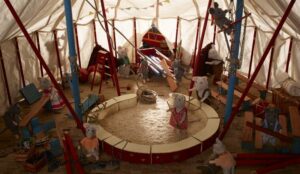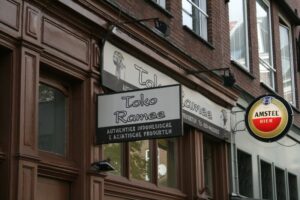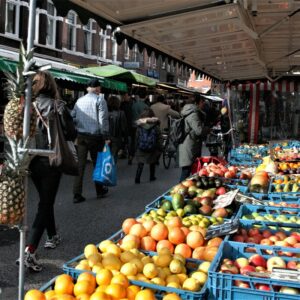See amsterdam through the eyes of A local
Discovering Amsterdam with a local is an experience in itself. The best part of Amsterdam are the Amsterdammers – these sassy, whimsical, pragmatic, and unapologetically free people.
In our lifetime in Amsterdam, we’ve come to meet some truly amazing locals. People of different ages, with different jobs, memories, voices. But they have one thing in common – a deep personal connection to Amsterdam. Many have been living here for generations.
We asked them to share their stories of Amsterdam: their favorite places, things to do, what they are proud of and what they dislike. These conversations are unfiltered and honest, just like the real Amsterdam we like to show to our guests. Enjoy a glimpse of Amsterdam with a trusted local!
Paris has Ratatouille. Amsterdam has The Mouse Mansion. This quirky little shop in the quaint district of Jordaan has been a local institution since 2017. Today, it is visited by children and grown-ups from around the world.
An entire wall is occupied by the most detailed mouse house you’ll ever see. And although many people describe the Mouse Mansion as a dollhouse, it is something else: it is the setting for a heartwarming story about humanity. It is home to Sam and Julia, two mice friends invented by Karina Schaapman – a former member of the Amsterdam City Council, a writer, and a mom of four.
Since 2011 Karina has written six books about the adventures of Sam and Julia. Every book is illustrated with photos of their intricate Mouse Mansion, hand-made by Karina over several years. Translated in twenty-seven languages, the books have become a resounding international success.
Karina has been an adopted Amsterdammer since over forty years. De Jordaan has been her stamping ground. This is where she lived and were she raised her four children. It only makes sense that the Mouse Mansion store is also here. We sat down to talk with her about her city, her life, and her Mouse Mansion – a miniature mouse society with a promise of a better world.
How does one get from a career in politics to working full time on a Mouse Mansion?
Through a surgery. I had been working for six years on the Amsterdam City Council when I was diagnosed with a hernia, in 2008. After the surgery, I needed to rest, both physically and mentally. As a politician, I had been dealing with very intense social issues, and it was extremely demanding.
I took this break as an opportunity to think about what I really wanted to do. I had a long-time dream: to write a children’s book. I had already published two books for adults before, but I had never had the time to make one for children while my own kids were young.
My first step was to simply figure out what kind of universe I wanted to create for children. This was the starting point. I already knew that the characters would be called Sam and Julia, but they were sketched out in my mind as humans, not yet as mice.
What sort of world would they live in? As a member of the Amsterdam City Council, I had already focused on children’s issues. I had fought for better health coverage and education, and against discrimination and child abuse. The world I wanted to create would be a safe place, a place of love and care. This is the story I wanted to put into shape in the Mouse Mansion.
I have had a very turbulent life myself. Growing up, I lived with my mother. We were very poor and lived on welfare. We usually ran out of food by the end of the week. I remember being often hungry on weekends. I had a little book about mice – I didn’t own many books or toys otherwise. I vividly remember the image on the back cover. It was the mother mouse holding a big pot of warm pudding. That image always energized me. It gave me hope.
And then, there was love. It was my mother who gave me the strength to go through my life. If I haven’t ended up as a junkie, it is because I had received a lot of love from her in my early years.
So, I thought that it was important that a book gives a child an image of something that they really want. Something to fuel their dreams. And something filled with love.
Sounds like a great inspiration! But more precisely, where did you start?
Well, now that I knew what kind of world I wanted to create, I had to start building it. It took me three years to complete the first setting. It had grown to a 6,5 feet wide and almost 10 feet high maze of more than a 100 rooms filled with details and storytelling. It is permanently on display at the Amsterdam Central Library (next to Central Station), and worth a visit on its own.
The Mouse Mansion is incredibly detailed. Simply because, to me, care is not just a fluffy idea. It has to be tangible.
The first rooms came to life inside a big carton. I used all sorts of materials: popsicle sticks for wooden floors, bottle caps for lamps, papier maché, and so on. I have always been handy. That, too, comes from my childhood. My mother couldn’t afford buying me toys, but she was very creative. Once a month, on ‘garbage day’, we would pick up stuff from the street and build crazy things together, like towers of old chairs. When my children were little, I made dolls for them – which eventually developed into offering workshops for other parents.

Some rooms of the Mouse Mansion look a lot like the one I used to live in. But it’s not just about my personal story. To many readers, every item is recognizable. Parents and grandparents point out to their children objects from their youth, like little pieces of fabric from the 1950-60s. ‘That’s how our house used to look!’, they say.
What about the two residents of the Mouse Mansion, Sam and Julia?
Every detail matters in this house, and that, of course, is also true for the characters. Just from how they look, you can say how different they are. Julia is slender, and her fur is rather rough. Her friend Sam is all round, made with soft fabric. Julia is lively, adventurous, enterprising. Sam is shy, gentle, cautious. They complete each other perfectly. Needless to say, as a girl, I was a lot like Julia.
I always played with boys, climbing trees and doing other boyish things. Considering the animosity of our neighbors, the outside world was frightening – but also very exciting for an adventurous kid like me.
The stories of the Mouse Mansion are mostly taken from my own life, but with a positive flip. I turned everything harsh into a good experience. In a sense, it was a continuation of what I had been trying to do in politics: building a better world. Only it’s much harder in real life. An ideal world comes to you naturally in a story. You just need to make it about mice. But in the end, it’s all about humans.
Any lessons to learn from the Mouse Mansion, then?
Indirectly. It’s not a pedagogical project, but it does draw on a few fundamentals. The most important one, for me, is inclusivity. I know first-hand how devastating it is for a child to suffer from neglect and discrimination.
My mother and I were “different”. She was Indonesian. At the time, the Dutch were not used to immigrants. Besides, she was a single mother, which was frowned upon. She appeared very exotic. She looked, dressed, talked differently, and cooked food that smelled weird. Our neighbors didn’t mind telling us that we stank and that we should ‘go back to our country.’ Most of them wouldn’t let their children play with me.
I lost my mother when I was 13. She had been sick for months, and during that time, I was left alone. I couldn’t take proper care of myself, and I didn’t know better than bringing home things from the garbage. The neighbors kept complaining about the stench, but they did nothing to help me.
There is zero discrimination at the Mouse Mansion. It’s a place where everybody can be different in peace, together. In fact, the best part of the house is probably the staircase – the place of encounters. And the mice learn not to be afraid of the unusual.
Is it something you also remember from your childhood?
I did have a chance to discover that difference can be a strength. It was a quite special experience.
I was about eight. We lived in Leiden. Every year, for two days, a circus came into town. Imagine the thrill! My mother couldn’t buy me a ticket, but I was allowed to watch the show from behind the curtains in exchange for giving a hand backstage.
One night, I stayed too late, and my mother came to pick me up. She met the director. They fell in love. And for the next five years, the circus became a part of my life. I went to school during the week and toured the country with the circus on weekends.
It was a very happy time. What I loved most at the circus was that everybody was different – but it was seen as a talent to foster, not a problem to fix. Just the opposite of what I had seen before! I especially admired the trapezist, so graceful and strong in her fishnet stockings and golden tricot. But I was too wild for the trapeze. Instead, they taught me to walk on the rope. Turned out, learning to find your balance is a pretty useful skill in life!
The “circus era” ended when I was 13. TV sets had become widely available, and the circus went bankrupt. My mother’s boyfriend, the circus director, had to leave to work abroad. My mother fell ill, and died six months later.
I was sent to a new school, where nobody knew me. I felt very lonely. I didn’t realize it might be helpful to talk about it. It was uncommon, at the time, to discuss death and grief with children. Today, loss is surrounded with more rituals. I included in one of the books an episode where Sam’s grandfather dies, and the young mice decorate his coffin together. It’s something that I saw children doing. Two young boys in my neighborhood had lost their father, and they helped decorating the coffin. We did that with my little nephews, too, when my brother-in-law died. Since the book, I have heard from several school teachers that they use this story as a conversation starter to talk to children about grief.
Has the Mouse Mansion inspired people in other ways you had not expected?
It went far beyond anything I had expected! Initially, I had only had young children in mind, from three to eight years old. But eventually, it reached a much larger age range. Toddlers love the illustrations. Older children and even grown-ups took on building their own mouse houses. That’s how we started offering Mouse Mansion building kits.
Schools around the world do projects based on the Mouse Mansion. Architecture students study it at the University of Delft. Autistic teenagers are fascinated with all the details of the Mouse Mansion.
But the most touching group of guests turned out to be people with mental disabilities. Older guests with dementia love the stories of old traditions – they remind them of their childhood. A number of care centers use the books to help their patients calm down. I could never have imagined any of this!
Living at the Mouse Mansion seems to be a lot about food…
Food is very important. For example, Sam’s family is Jewish – inspired by my husband’s Portuguese Jewish origins. In one of the books, they share a traditional Jewish meal. In other books, it’s about Muslim or Christian food traditions.
Food is a cultural cement. I took Indonesian cooking lessons when I was about 18, to feel closer to my mother’s origins. Later, in my own house, I cooked Indonesian food for an army. All the neighbors’ kids were hanging out at our place. Plus my own four. Our apartment on Looiersgracht was tiny, but with all these children there, it didn’t feel small. Because you don’t need a lot of space. Space is in your mind.
Speaking of food, any Indonesian places you recommend in Amsterdam?
I’m not into fancy restaurants, and since I cook myself, I am very picky. But I do have a couple of favorites. One of them is the Surinam restaurant ‘Nieuwe Albina’ in De Pijp – a very mixed clientele, a relaxed atmosphere, and always a very good meal.
I get my ingredients for my indonesian recipes at ‘Toko Ramee’, on the Ferdinand Bolstraat in de Pijp – the best place to go if you cook Indonesian food.
The best hummus comes from the Iranian food stall on the Ten Kate market, next to the Kinkerstraat. They have twenty kinds of hummus. Besides the Ten Kate market, I believe the best street market in Amsterdam is the Dapper market, in the east of Amsterdam. 

The Surinamese, Caribbean, and African restaurants in the South-East of Amsterdam are very good, the area of the Bijlmer. Historically, it’s an area with a large Surinam, African and Caribbean community. These people love to eat, and they are very demanding of their food, so the quality is always high.
And not food-related spots?
Obviously, I love wandering around flea markets hunting for furniture. The one on Waterlooplein is my favorite. You can browse through lots of things from abandoned houses, and you never know what you may find.
Another thing I could recommend parents to do with their children, is simply to take the ferry across the IJ from the Amsterdam Central Station to Noord. The views are fabulous!
I keep my eyes peeled for new favorite spots now that I have young grand-children. Exploring Amsterdam with a child is a whole different experience.
You work with your children. How has the Mouse Mansion become a family business?
We have been a family company since about three years. My children became involved in the project gradually. It had started with a temporary project, and now, most of them work full-time: running the shop, the YouTube channel, reviewing various merchandising requests, and so on. It takes a lot of work.
And we are planning to grow further. We are currently looking for a larger place, which would bring together the shop, a museum, and a restaurant. But finding a location in Amsterdam is a challenge.
You have been an adopted Amsterdammer for 41 years now. What does “your” Amsterdam look like?
“My” Amsterdam has long been centered around the Jordaan district. My first apartment, at age 17, was in the Gietersstraat, in an old factory. Then I have lived for 26 years along the Looiersgracht, raising my children there. Now I live in Amsterdam Oost, but the Mouse Mansion shop is in the Jordaan – it is still my home base.
I have seen it change a lot. In the late 1980s, entire streets were full of junkies and abused women. Since then, the social programs have been developed, and the city cleaned up a lot. Although I notice, since the last couple of years, that there are more and more homeless people in Amsterdam again, due to cutbacks in these programs.
The growing number of tourists is not a problem for me personally, especially from the business point of view. But, of course, it creates issues for those who live in the central areas. It’s crucial to have a human connection with your neighbors. And how can you build a connection if everything becomes an Airbnb? Even in my current neighborhood, in the East, a lot of houses are being bought specifically for short rentals. They end up standing empty for most of the year.
What is the worst thing about Amsterdam?
Without any doubt, the Red Light district. It is disgusting. Tourists get the wrongest idea of it. It is all about crime and human trafficking. I am ashamed that it is still there, and that it is such a tourist magnet.
What is, to you, the greatest quality of Amsterdam?
The diversity. It always strikes me how uniformly white other Dutch cities are, like Haarlem or The Hague. I’m always happy to come back in Amsterdam.
We have a good mix of incomes. A growing gap between the richest and the poorest is dangerous, and unfortunately, Amsterdam has its share of very poor people. But it is nothing like many other European capitals, where you can see entire families on the street. Amsterdam remains socially inclusive and takes good care of fragile people. The police is seen as helpers and friends – otherwise how could we manage so seamlessly all the big festivals we host? We have the gay parade and football games and Amsterdam can handle all these visitors. I am very proud of all that.
If you could get a message on a billboard for people coming to Amsterdam, what would it say?
Try to see the real Amsterdam. Look for non-touristic spots. I try to do that every time I travel.





